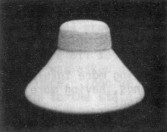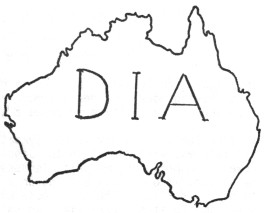Foreign Insulators
by Marilyn Albers
Reprinted from "INSULATORS - Crown Jewels of the Wire", August 1980, page 2
DIA -- Doulton
Insulators Australia Pty. Ltd.
Most of us, when we hear the name Royal Doulton,
think only in terms of beautiful figurines, fine china tableware and Toby jugs.
So it was a surprise to me when I learned that Royal Doulton makes insulators,
too! The history of the company and its growth through the years makes a
fascinating story.
In the year 1815, a young man of 22, named John Doulton,
ventured his entire savings of £100 (100 pounds) on a partnership in a small
Thames-side pottery in Lambeth, London. From this humble beginning has evolved
the now world famous Royal Doulton group of companies.
Early Doulton products
included stoneware figure-jugs representing Napoleon, King William IV, the young
Queen Victoria, etc. The main production, however, was of plain bottles and jars
for beer, spirits, boot blacking, inks and chemicals.
The first impetus to
expansion came from the demands of the then rapidly developing chemical
industries for acid resisting stoneware plants. John Doulton was quick to seize
the opportunity, and by the middle of the century had become the largest
producer in the world of this material.
In 1835, Henry Doulton, John's second
son, entered the business at the age of 15. He quickly mastered, with
extraordinary aptitude, the basic processes of pottery making. An early outcome
of his inventiveness was the use of steam to drive the potters' wheels. In this
the Doulton factory was ten years ahead of any other.
In 1846, Henry Doulton
established in Lambeth the first factory in the world for the manufacture of
stoneware pipes for drainage and sewerage. Within the next few years the demand
became so great that other Doulton factories had to be opened in Staffordshire
and Lancashire.
Improvements in drainage and sewerage of towns led to the
increasing use of pottery closets, wash basins, sinks and similar equipment. The
production of these became and still is another important branch of the
business. Oh, would that I might have in my guest bathroom a commode emblazoned
with Royal Doulton! And I suppose if I should ever need a plumber, I would look
under the "Fine China" department of Neiman-Marcus!
The introduction
of the electric telegraph in the 1840's created a need for ceramic insulators.
Henry Doulton was one of the first potters to supply these. Insulators for the
telephone systems, early power stations and electrified railways were
subsequently developed.
In 1867, at the Paris Exhibition, Henry Doulton
introduced a few simply decorated stoneware vases designed by George Tinworth
and other students at the Lambeth School of Art. These made such a favorable
impression that during the next three decades the number of artists and
designers grew into hundreds, and 'Doulton Ware' was shown at one great
exhibition after another, taking highest international honors.
In 1877, Henry
Doulton extended his interest into the field of fine earthenware by acquiring an
old established pottery at Burslem and engaging a very distinguished staff of
designers, modelers and artists. In 1884 he added a new wing to this plant and
began producing fine bone china.
On the death of Sir Henry in 1897, his
son, Lewis Doulton, formed a Limited Company, which began trading as Doulton
& Co. Ltd.
In 1901, King Edward VII conferred a double honor upon the
company by presenting it with his Royal Warrant and, at the same time,
authorizing it to use the word 'Royal' to describe its products. As some
manufacturers have themselves assumed the designation 'Royal', it must be
emphasized that the Doulton Potteries use this distinguished prefix by virtue of
a specific privilege granted by Edward VII.
Up to this time a few Doulton
figurines had been made, but in 1920 production of these began in earnest. Next
came animal models, and in 1930 appeared the first Royal Doulton Toby jugs and
character jugs.
Meanwhile at the Lambeth and other Doulton factories equally
important progress had been made in meeting the specialized needs of architects
and builders, chemical, electrical and sanitary engineers for other types of
ceramics. One of the remarkable features of the Royal Doulton Potteries has been
the high reputation they have won in industrial and technical ceramics as well
as in fine china for domestic use.
By the 1930's it was apparent that the
Lambeth Thames-side would soon be no longer a suitable site for a large
pottery-works producing a vast range of entirely different products. It was
realized, too, that some of these products were no longer economically viable,
and that, to take full advantage of modern processing methods, it would be
necessary to concentrate clearly defined and profitable product groups in
separate units.
Long term plans were made to discontinue gradually pottery
making at Lambeth; to reorganize and modernize the other factories; and to build
or acquire new works in suitable areas. By 1939 a beginning had been made, with
the erection of a new factory in Kent and the purchase of two old and
established potteries in Staffordshire which had considerable development
potential.
In 1946, a selling company, Doulton & Co. Inc., was established
in New York as the first step in a new merchandizing policy for fine china
products in the North American market.
In 1956 the Lambeth Works was closed. In
the same year the first four subsidiary manufacturing companies were created to
deal with the manufacture and sale of distinct product groups. 1956 also saw the
beginning of new developments in Canada and Australia, which subsequently led to
the formation of subsidiary companies in these markets. One of these was formed
when Doulton bought the already established API (Australian Porcelain
Insulators) and renamed it DIA (Doulton Insulators Australia). So you may come
across insulators marked either way, depending on whether they are
"pre" or "post" Doulton. There are two DIA plants of
operation. The first one to be established was at Tamworth in the State of South
Wales, followed by a second located in Melbourne, Victoria. It is called their
Yarraville factory. DIA insulators of many types are produced not only for use
in Australia, but transmission line disc insulators have been sent to Iran, and
post insulators and distribution line insulators have been exported to Mexico.
Orders for post insulators from Rumania and hollow porcelains from Hungary
signify important penetrations of the Eastern European market. Work for the
Canadian Nelson River D.C. project has entailed the production of the largest
porcelain housing yet undertaken at Tanworth. A picture of it in the catalog
made it appear more than twice the height of a man six feet tall.
Throughout DIA insulator production special interest has been taken in the
design of insulators for operation under polluted conditions. In Australia
atmospheric pollution arises from the use of local brown coal which the power
stations are designed to employ, but it creates a particular design problem.
Here, and in other countries, as operating voltages and the length of
transmission lines have increased, the problem of maintaining continuity of
supply under varying atmospheric conditions has become more acute. Countries
once considered free of pollution are now meeting difficulties. In desert
regions, for example, pollution may be caused by wind-driven salts being
deposited on insulators during long dry periods; later, when condensation takes
place, surface breakdown over the insulator may occur. In industrialized
countries and in coastal areas there have long been more obvious causes of
pollution failures. The Australian engineers are greatly interested in this
problem, and this has resulted in different approaches to the question of
insulator design, often leading to a much simpler insulator shape than was
formerly supposed necessary for polluted areas.
Since the beginning of this
century, the name Doulton has been associated with railway electrification.
Immense quantities of insulators have been supplied for the D.C. systems of
British Rail Southern Region and London Transport and for the overhead 25 KV
A.C. systems of Eastern, Midland and Scottish regions. Most of the Doulton
insulators supplied for these systems have been the solid core one-piece type.
Recent developments have been directed towards reducing the size of insulators,
for economic reasons, and toward the use of stabilized insulators (from
Tamworth) for polluted areas.
I wrote to the Yarraville plant in Melbourne
several weeks ago requesting updated material which, hopefully, would include
sketches of their various insulator types, since I have not a one in my
collection! So far I have not had a reply and have none to show you at this
time. But I do have a snapshot of a few DIA insulators from Lu Farin's
collection (Decatur, Texas) which she and her husband managed to bring back from
a tour through the plant in Melbourne when they went to Australia in 1972. These
are most interesting! They are all porcelain (as are all DIA insulators). #1, #2
& #3 are avocado green, #4 is chocolate brown, and the fifth one is light
grey. In the picture #1 and #4 are probably the only complete insulators, while
the others appear to be parts of insulators. #1 and #5 have sand bands applied
to their crowns and inside the pinholes (no threads), while #4 has a standard
1" threaded pinhole. The largest in the group is the light grey one -- 5" tall and 7" across the base.

|
Fig. 1 |
Fig. 2 |
Fig. 3 |
Fig. 4 |

Fig. 5

Two of the insulators bear the DIA trademark with manufacture
date -- Sep
72. It shows the outline of Australia. The others probably missed the trademark
because their other "parts" were intended to bear it.
None of these
insulators have ever been used. They came right off the assembly line. During
her tour of the plant, every once in a while Lu would say "Oh, that's a
nice one!" and s-w-i-s-H!! it was hers! Apparently the plant manager was
the one who took them through and was super obliging since he'd made them wait
nearly an hour before he was free to see them.
Thanks to Lu Farin, one more
time, for her great help.
| 